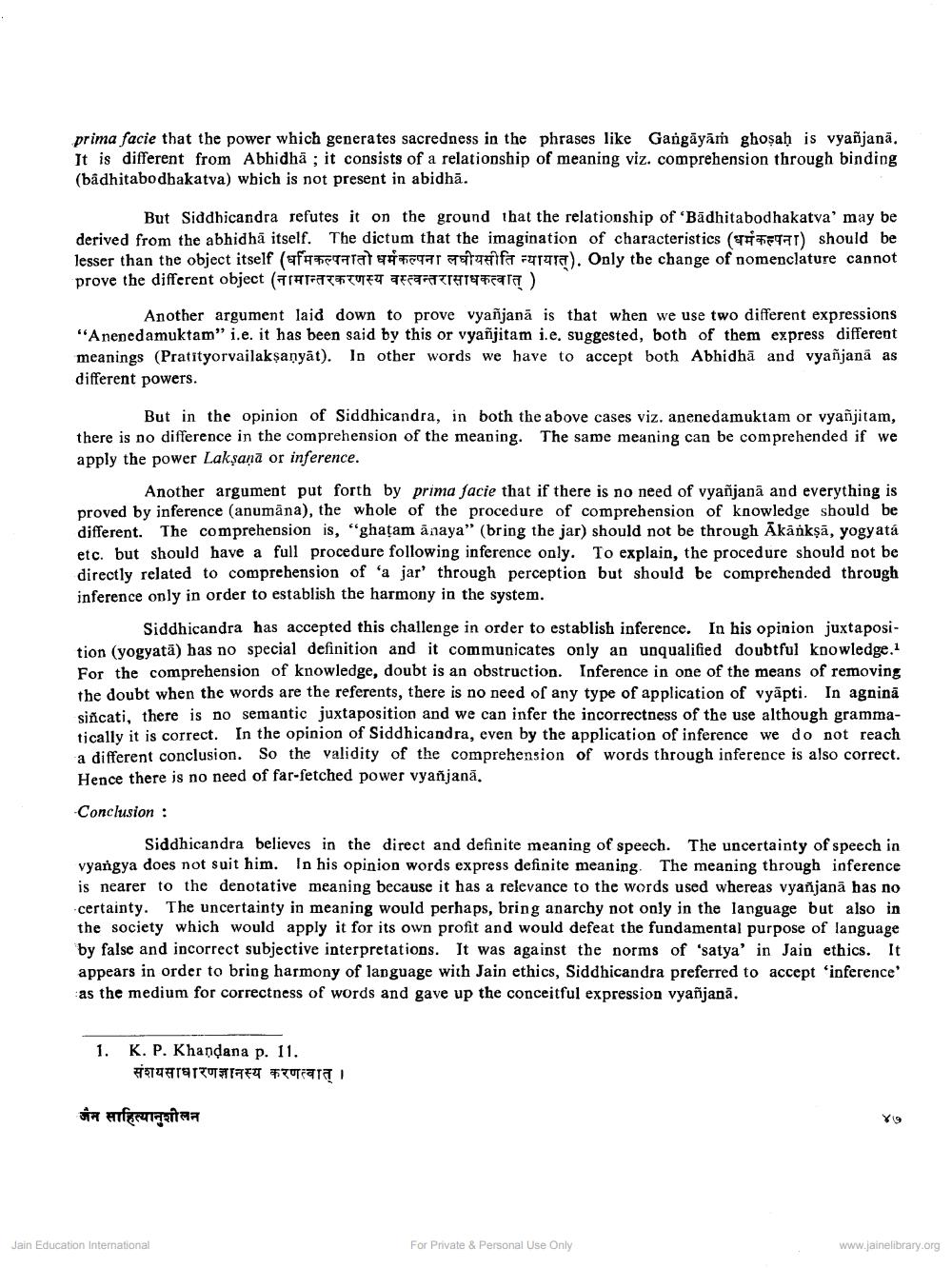Book Title: Exposition of Sabda Shaktis by Siddhichandra Gani Author(s): Satyapal Narang Publisher: Z_Deshbhushanji_Maharaj_Abhinandan_Granth_012045.pdf View full book textPage 4
________________ prima facie that the power which generates sacredness in the phrases like Gangayam ghosah is vyanjana, It is different from Abhidha; it consists of a relationship of meaning viz. comprehension through binding (badhitabodbakatva) wbich is not present in abidha. But Siddhicandra refutes it on the ground that the relationship of 'Badhitabodhakatva' may be derived from the abhidha itself. The dictum that the imagination of characteristics (THETAT) should be lesser than the object itself (मिकल्पनातो धर्मकल्पना लघीयसीति न्यायात). Only the change of nomenclature cannot prove the different object (TraTETTATUFT AFFOFTTTTTTTTT) Another argument laid down to prove vyanjana is that when we use two different expressions "Anenedamuktam" i.e. it has been said by this or vyanjitam i.e. suggested, both of them express different meanings (Pratityorvailaksanyat). In other words we have to accept both Abhidha and vyanjana as different powers. But in the opinion of Siddhicandra, in both the above cases viz. anenedamuktam or vyanjitam, there is no difference in the comprehension of the meaning. The same meaning can be comprehended if we apply the power Laksana or inference. Another argument put forth by prima facie that if there is no need of vyanjana and everything is proved by inference (anumana), the whole of the procedure of comprehension of knowledge should be different. The comprehension is, "ghatam anaya" (bring the jar) should not be through Akanksa, yogyata etc. but should have a full procedure following inference only. To explain, the procedure should not be directly related to comprehension of 'a jar' through perception but should be comprehended through inference only in order to establish the harmony in the system. Siddhicandra has accepted this challenge in order to establish inference. In his opinion juxtaposition (yogyata) has no special definition and it communicates only an unqualified doubtful knowledge.1 For the comprehension of knowledge, doubt is an obstruction. Inference in one of the means of removing the doubt when the words are the referents, there is no need of any type of application of vyapti. In agnina sincati. there is no semantic juxtaposition and we can infer the incorrectness of the use although grammatically it is correct. In the opinion of Siddhicandra, even by the application of inference we do not reach a different conclusion. So the validity of the comprehension of words through inference is also correct. Hence there is no need of far-fetched power vyanjana. Conclusion : Siddhicandra believes in the direct and definite meaning of speech. The uncertainty of speech in vyangya does not suit him. In his opinion words express definite meaning. The meaning through inference is nearer to the denotative meaning because it has a relevance to the words used whereas vyanjana has no certainty. The uncertainty in meaning would perhaps, bring anarchy not only in the language but also in the society which would apply it for its own profit and would defeat the fundamental purpose of language by false and incorrect subjective interpretations. It was against the norms of 'satya' in Jain ethics. It appears in order to bring harmony of language with Jain ethics, Siddhicandra preferred to accept 'inference' as the medium for correctness of words and gave up the conceitful expression vyanjana. 1. K. P. Khandana p. 11. संशयसाधारणज्ञानस्य करणत्वात् / जैन साहित्यानुशीलन X9 Jain Education International For Private & Personal Use Only www.jainelibrary.orgPage Navigation
1 2 3 4
